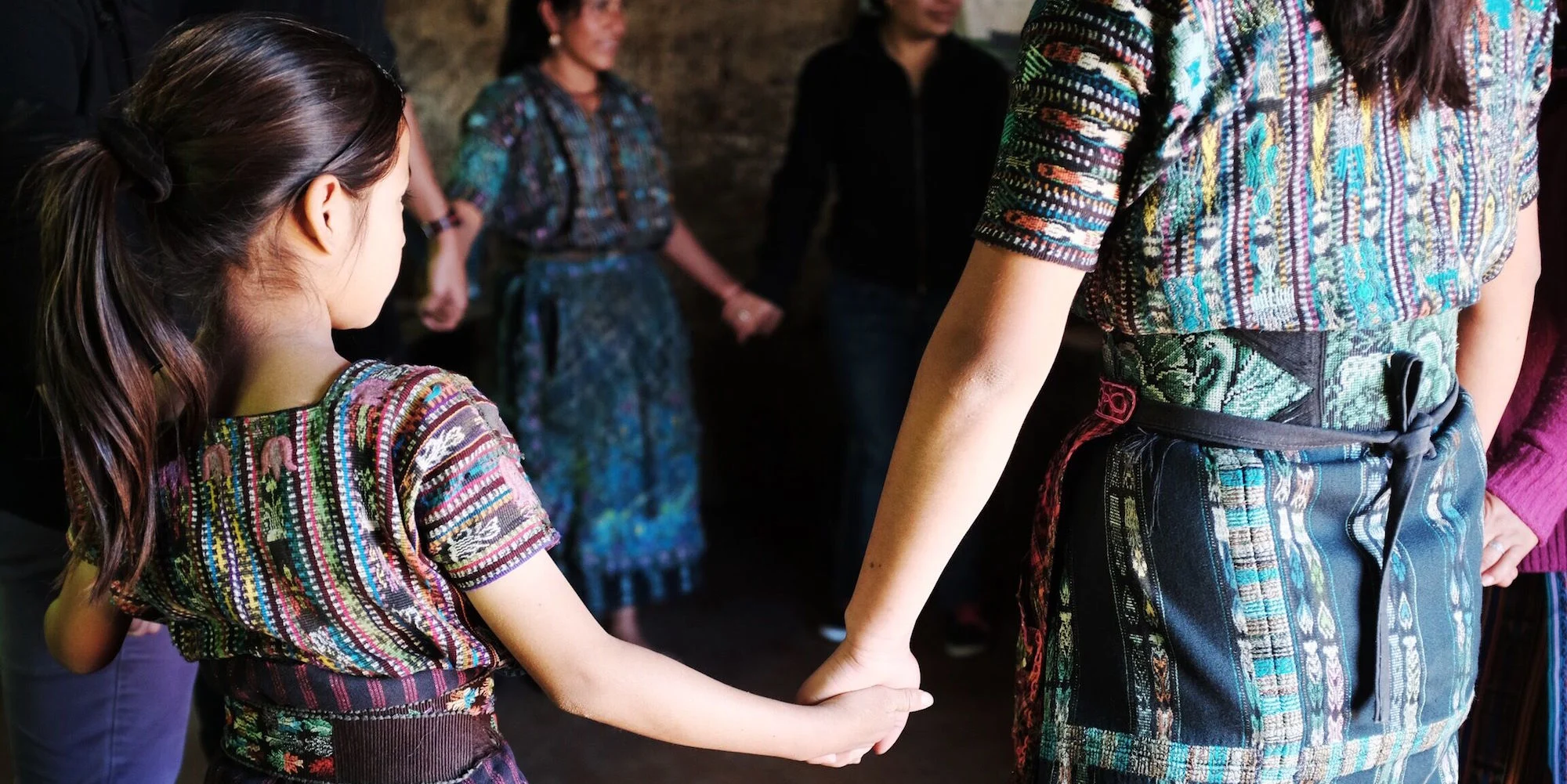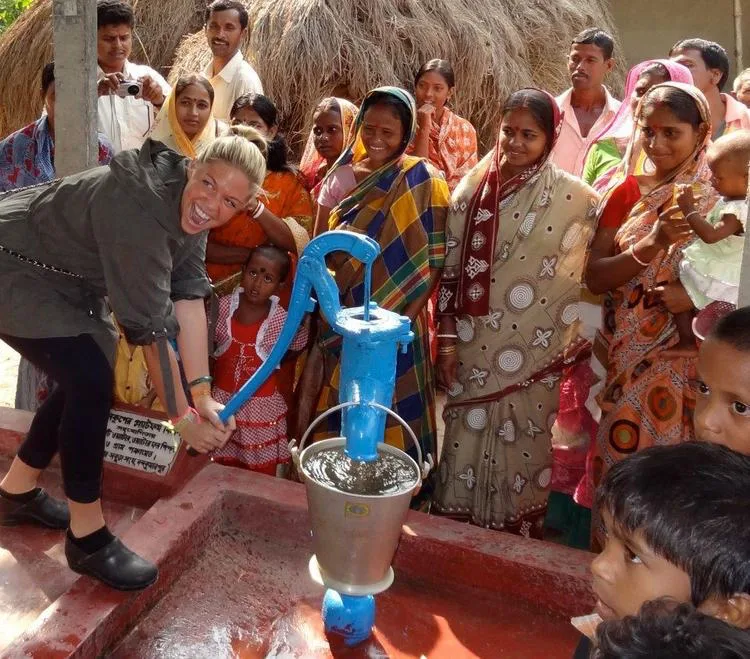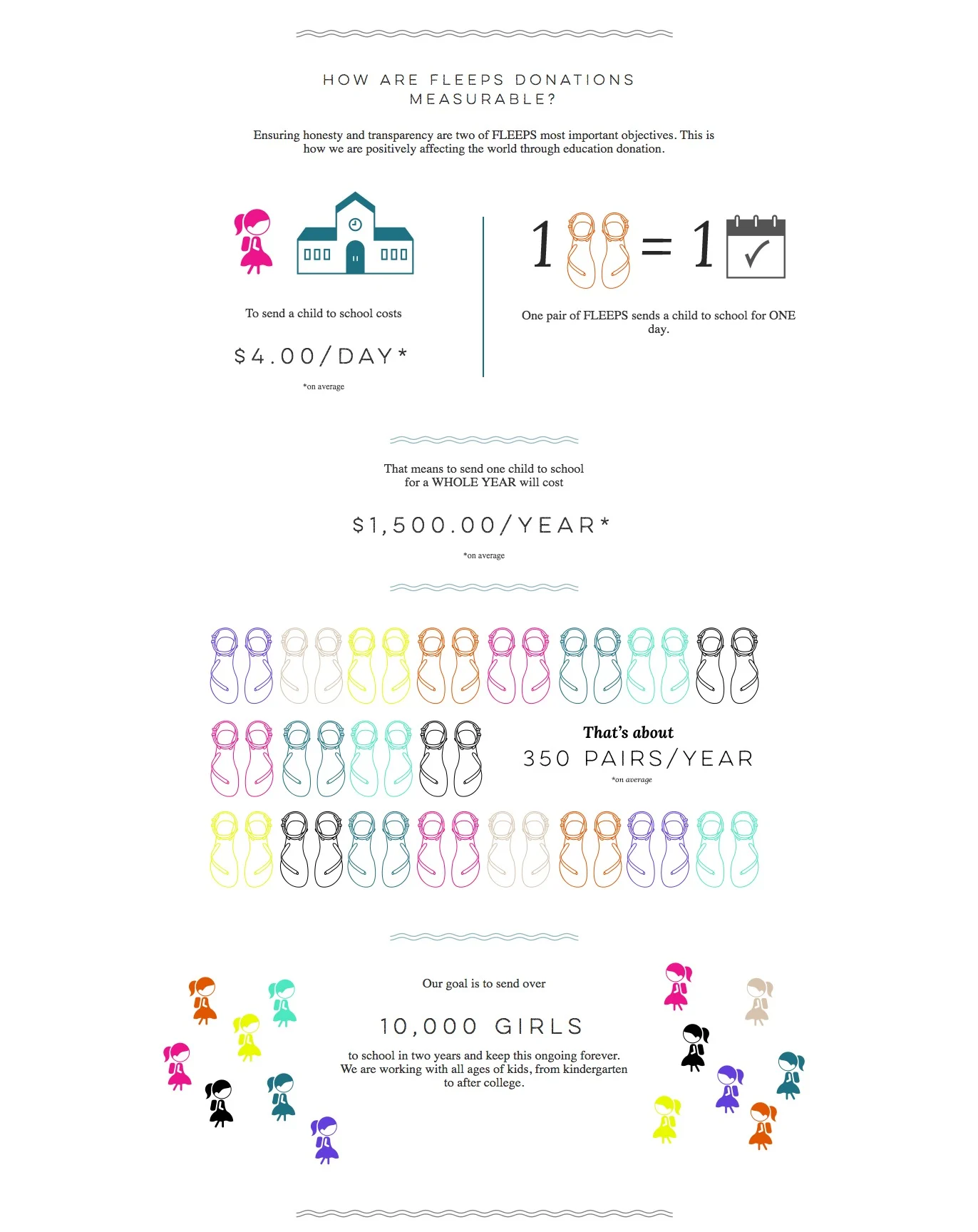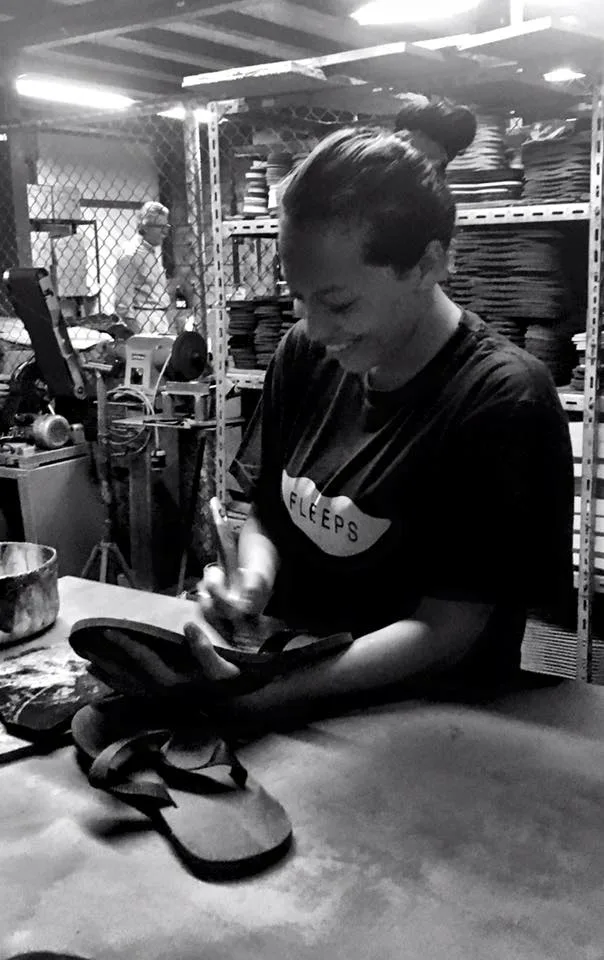Oh the Places Your Purchase Will Go –– And the 10,000 Girls It Will Educate

It started in Australia and Fiji, destinations typical enough for a teenage American traveler. The trip and agenda were coordinated by Outward Bound, a study abroad agency for middle school, high school and college students based in the U.S.
The goal for Outward Bound is to build confidence for attending students –– take them out of their comfort zone, give them a light push over the edge into unknown territory and new hobbies, and open their eyes to a world beyond their hometown or ingrained societal expectations.
It’s all in the name of fun, growth and living a life a bit larger than yourself.
At 16, Kael Robinson, founder of footwear brand FLEEPS, took those ideals one step further.
The program dropped the Philadelphia teen into rural villages that were both physically and psychologically half a world away. Her days consisted of working and playing with kids in the low-income areas of her new, albeit temporary, home.
The trip proved to be a pivotal one for her; a series of moments coalescing into an understanding that she would never be the same. Something had changed. Her eyes had been opened. The world as she knew it was different, bigger –– and she was determined to also make it better.
“I realized the world I was living in as a high schooler in Philadelphia was a lot different than the world out there. It gave me this perspective that if people are this happy with nothing around the world, then how come people are so unhappy when they have everything.
As I got older, I realized I wanted to allow people to get a perspective of what the world is like outside of their own little environment.”
The Nature of Travel

There’s something ephemeral about traveling –– any quick Instagram search will verify that. Accounts once hosting pictures only of selfies or group shots with friends on a school campus begin showcasing sunset images from Manuel Antonio in Costa Rica or small villages and beaches in Jamaica or Antigua.
You’ve seen these accounts, the ones that turn from self-interest into a larger awareness for nature and geography. You may even own one.
In 1869, Mark Twain commented on this perspective-shifting phenomenon, void of social media accounts at the time to be sure:
“Travel is fatal to prejudice, bigotry, and narrow-mindedness, and many of our people need it sorely on these accounts. Broad, wholesome, charitable views of men and things cannot be acquired by vegetating in one little corner of the earth all one’s lifetime.”
Travel, whether to the resort towns mentioned above or beyond –– to areas stricken with poverty or alive with a culture wholly unknown to the visitor –– and one thing is certain: you don’t come back the same.
What you do with that change defines who you become.
Do you learn a new language?
Dedicate yourself to a life of travel?
Do you find love abroad, in either a person or a hobby, and pack up your things once and for all?
You wouldn’t be alone for doing so.
Today, the widespread usage of the internet makes the world seem much smaller, and Airbnb is making international travel more affordable. According to Adam Enfroy, when you compare the cost of living, you may realize that living in another country or becoming a digital nomad is more affordable than living in the United States. And convenience is key. Nowadays you can travel to Croatia or Bali, to Ecuador or Zambia, all with a downward flick of your finger on your mobile phone.
Add to that ease of worldly cultural and geographical access, the studies on the current generation. Millennials, those who reached young adulthood in the early 2000s and for whom this image will always strike a fond chord, give back to charities and philanthropies more so than any other generation.
The Case Foundation, a non-profit investment organization, defines this generational desire as such:
“The Millennial generation is a tech savvy, entrepreneurial, educated and independent-minded cohort that is driven to ‘do good.’”
Fair enough –– but for businesses, what really matters is this:
“More than 80 million Millennials worldwide represent a collective $170 billion in purchasing power.”
And when you combine that purchasing power with philanthropy, you get the rise of cause commerce –– what Twain called “charitable views of men and things,” and what Kael has made a career of.
The Origins of Cause Commerce

Cause commerce hit mass velocity with the public through TOMS Shoes and Warby Parker. Their models hinge on the convenience of giving back, while still enabling consumerism.
During the rise of these two companies, millennials were in high school and early adulthood (about 15-28, though there is no set date range for which age groups make up the whole of ‘millennials’). The economy was poor. An eye toward internationalism was commonplace. After all, the Iraq war and subsequent uprisings in Africa (remember Kony and the LRA?) and, later, the Arab Spring proved how social media, justice and even social change could work hand-in-hand to spread information, rally bodies and make history.
Companies providing both a product and a mission boomed –– and it was by millennial dollars they did so. But TOMS and Warby Parker weren’t the only two of their kind.
On Brazil, Bracelets and Being Agile
Less than five years after her first trip abroad, Kael was out of the States again –– this time in Brazil. There, she stumbled upon popular, locally-made bracelets that carried with them a sense of fortune and good will –– and buying them helped support the native economy.
“The bracelets have a huge tradition around good luck and spirituality,” Kael told me. “Basically, you tie them on your wrist and when it falls off, your wishes come true.”
[When Brazilets was launched], we were bringing awareness to the Amazon Rainforest, on how bad the destruction was that was going on there –– what it will do for our planet. We focused on environmental issues.
Then, it evolved into buying products from 30 countries, giving back to about 15 different non-profits. That’s Live Worldly.”
Today, Live Worldly is no longer a cause commerce business. Instead, it serves a similar function to Outward Bound, the service Kael used to make her initial trip abroad. Through Live Worldly, Kael and her team bring 50 people each year to a different international location. The goal is to give back to the community, and to provide an unforgettable, if not eye-opening, experience to the travelers themselves.

For Kael, however, there is much more work to be done outside of opening minds and raising awareness –– which is why only a year ago, she launched her second cause commerce company off the back of an email chain:
“I just randomly emailed [one of Live Worldly’s country reps], ‘Hey, do you know of any manufacturers for sandals in Costa Rica? We are looking for locations outside of China.’
He actually emailed me back immediately:
‘Hey, a friend of my parents, this guy who owns [such a manufacturing company] just emailed me asking if I had any American clients that are looking to manufacture sandals.’
It was actually one of the weirdest things. We were very close to working with another manufacturer, but we dropped everything to try out this Costa Rican manufacturer. It was one of those ‘timing is everything’ things.”
This manufacturing switch put the launch of the new company six months behind –– an investment Kael views as well worth the wait.
Fashionable Footwear with a Mission in Mind
Meet FLEEPS, Kael’s newest company. Already a partner with Mercedes Benz Fashion Week and Models with Minds, as well as non-profits Shofco and Starfish, this sandal company is garnering attention, and earning charitable dollars, from the fashionable, yet philanthropic community.
Similar to her bracelet initiative, FLEEPS employs local workers and ensures fair wages for often underprivileged communities –– this time in Costa Rica. The company’s focus is on both the environment –– through ethical and eco-friendly material and production practices –– as well as on quality education.
“We chose this manufacturer specifically because of the conditions and the program they have for their employees. They employ a little over 100 people every year from a slum in San Jose, where they know people need the jobs. They go there to teach them how to make shoes and sandals.
They use only materials that are vegan and that have zero carbon emission. They really try to keep everything healthy and good for the environment that they’re in.
I’ve gone down every three months in the last year to meet the new workers and also to provide information on what we’re trying to do to help their community, the slum where all the workers are from, and how we are giving back to the school in San Jose.”

The entire process is coordinated in the area through a non-profit known as Fisherman Sandals. It involves exactly what Kael described. A single manufacturer, which has been in business more than 40 years, pulls in 200 people annually, from all across Costa Rica, and teaches them how to make sandals. The students then go back to their communities to sell the fruits of their learnings and make money for their families.
“It’s a microfinance program where the workers are given the sole [of a shoe], like 12 pairs of soles for $12 dollars, and they can make the straps with any materials they want. Some are made with balloons. Some are made with rubber bands. Some are made with any materials, like cloth or fabric. It’s a really cool program. That’s where they employ a lot of those people to make FLEEPS.”
The Fruits of an Empathetic Business Model

“Do you have any cool stories about any of the workers you might be able to share?” I ask Kael on the phone. She perks up –– she’s been talking about the “cool stories” she hears all the time, over email and when she travels. One particular one comes quickly to her mind.
“Yeah,” she says without hesitation. You can hear her smile over the phone. “In January when I was down there, I met a woman named Rosa who has been working there for, I think, almost five years. Her husband had been diagnosed with cancer. From the first production of FLEEPS that we did, she was able to pay for chemo for him. He’s still with us today. It was a pretty crazy story.”
Fair wages, though, are only the tip of the iceberg when it comes to how FLEEPS gives back. Learning from her first business, and expanding on her original tried-and-true sustainable and philanthropic business model, FLEEPS gives back both pre- and post-purchase. First, to the community in which they are produced. Then, in proceeds to girls’ education across the globe –– 10% of each pair of shoes sold help to provide schooling for a young girl in a third-world country.

“Two of our biggest partners are Starfish Impact and Shining Hill. Starfish Impact is focused on girls education out of Guatemala. The other, Shining Hill, is for communities and they are located in one of the largest urban slums in the world, in Kibera, Kenya. They’ve come up with a really cool school program that allows the kids and girls to have healthcare, food, clothing, water and school supplies.”
To date, FLEEPS has donated more than $40,000 to these organizations.
The Next Wave of Charity: The FLEEPS Foundation
If you haven’t caught on just yet: Kael’s entrepreneurial spirit is unstoppable. She serves on the board of Starfish Impact, remains CEO of Live Worldly, is launching a brand new cause commerce business –– this time focused on clean drinking water –– in a few months, and is still not fully satisfied with FLEEPS’ status of giving back.
This is why she kickstarted The FLEEPS Foundation.
The goal of the Foundation plays harmony to the business overall. But, instead of only giving back to the aforementioned charities, the Foundation’s purpose is to send 10,000 girls in third-world countries to school –– for life (K-College).
For Kael, this isn’t a zero-sum game. Each pair of FLEEPS will still be made sustainably and provide fair wages for the workers. Each pair will also see 10% going back in proceeds to the charities outlined. And, once the company sells its one millionth pair of flip flops, the Foundation will launch into action.
“Our goal is to sell one million pairs of shoes and send 10,000 girls to school for life. That’s Kindergarten through college. I feel like the best way we can do that is to create our own foundation, then funnel that money to the right people or figure out how to actually build it on our own.
To do that, we would go into the countries and partner with the non-profits, build our own facility or orphanage to actually focus on creating our own program. This allows us to work with other non-profits, but we’d have our own program to make a difference faster.”
And while FLEEPS still has 998,900 (at time of publication, the real-time counter is on their website) more pairs to sell before the Foundation takes off, Kael has already thought through exactly where it would take hold.

She outlines the following ten countries as areas The FLEEPS Foundation would work to send at least 1,000 girls to school for life:
Guatemala
Kenya
Costa Rica
Nicaragua
India
Tanzania
Nigeria
Uganda
Brazil
Peru
The Importance of the Bottom Line
“Sure,” you may be saying. “Kael is a busy woman, and a good one at that. But what about the margins? What about the revenue?”
It’s a good question –– and a fair one. Philanthropic as it may be, FLEEPS is no 504 corporation. It’s a business after all. And all businesses must eventually turn a profit or face defeat. Worse for FLEEPS, too, is that without turning a profit, every good deed done along the line –– from fair pay to proceeds and beyond –– would be eliminated, the work accomplished partly in vain.

The need for revenue, here, is strong.
“With what we’re trying to do, the margins are important. We need to pay the people who are making the shoes and then also make sure we are getting by with our employees and really making a difference in terms of our non-profits and what we’re giving back. We have a mindset of: ‘If we’re making any money at all, we’re happy.’
Some margins are $10, some margins are $1. From the beginning, we structured [the business] so that we could have a distributor come along and [we could] sell the product for a third of the price. We put [those kind of pricing policies] in place to make sure we were good –– just so that we could get the shoes everywhere and selling in as many places as possible to make a difference on the backend.”
Turns out, for FLEEPS employees, customers and the charitable benefactors –– the old adage proves true: “You don’t have to be rich to travel well.”
FLEEPS is currently on a mission to sell 14,000 pairs by the end of the summer. Head on over to their site to buy a pair and help empower education across the globe.

Tracey is the Director of Marketing at MarketerHire, the marketplace for fast-growth B2B and DTC brands looking for high-quality, pre-vetted freelance marketing talent. She is also the founder of Doris Sleep and was previously the Head of Marketing at Eterneva, both fast-growth DTC brands marketplaces like MarketerHire aim to help. Before that, she was the Global Editor-in-Chief at BigCommerce, where she launched the company’s first online conference (pre-pandemic, nonetheless!), wrote books on How to Sell on Amazon, and worked closely with both ecommerce entrepreneurs and executives at Fortune 1,000 companies to help them scale strategically and profitably. She is a fifth generation Texan, the granddaughter of a depression-era baby turned WWII fighter jet pilot turned self-made millionaire, and wifed up to the truest of heroes, a pediatric trauma nurse, who keeps any of Tracey’s own complaints about business, marketing, or just a seemingly lousy day in perspective.


